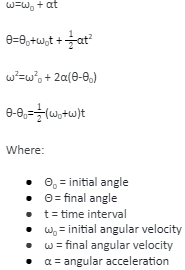A rigid body is a mass-bearing element with a restrictive form. Rigid bodies are capable of both translation and rotation motion. In such instances, both the translational and rotational velocities, which are linear, and the angular velocity, must be calculated. We describe the body’s translation and rotation motion separately to make these challenges comprehensible. Hence, understanding the dynamics of an object rotating around a fixed axis is correspondingly required to understand the body’s translation and rotation motion.
Rotational Motion
If each particle of a rigid body moves in a circle and the circles’ centres keep lying on a straight line, termed the axes of rotation, then the rigid body performs pure rotational motion.
The complexities of rotational motion are the same as those of linear or translational motion. Several estimations for rotating attribute mechanics are analogous to linear motion estimations and equations. In rotational motion, for instance, only inelastic bodies are considered.
When a body performs rotational motion, the rotational motion equations are written as:
Angular acceleration α is considered constant over the time interval.
Rotational Motion in a Fixed Axis
Rotational motion around a fixed axis depicts a rotating object with a point of zero velocity about which it is rotating. This particular point can be anywhere on the object’s body or anywhere other than it. Only those components of torques that are parallel to the fixed axis are considered in the rotational motion of a particle around a stationary axis that shall be fixed. The elements of force cause the rotation in the object’s body. The perpendicular component of the torque will typically turn the object’s axis of rotation from its position.
This means that some required and defined forces will eventually attempt to withdraw the impact of the components which are reflected to be perpendicular. This causes restriction of the axis movement in correspondence to its fixed position. Hence, this results in the position of the object to be retained. Since the perpendicular elements have no impact, they are ignored during measurement. Only forces that keep lying in planes perpendicular to the axis should be considered for any rigid body rotating about a fixed axis.
Rotational Motion Examples
Rotational motion with a fixed point: Rotation around a fixed point is seen in the spinning of a ceiling fan, the movement of the minute and hour hands in a clock, and the opening and closing of a door.
Rotational motion in a rotational axis: Translational and rotational motion are both implicated in rotation around an axis of rotation. Releasing a ball from an inclined surface is the most precise illustration of rotation about an axis of rotation. The ball approaches the bottom of the inclined surface through translational motion, while a ball’s movement is rotational motion as it rotates around in its axis.
The motion of the Earth is yet another illustration of rotation around an axis of rotation. Day after day, the Earth rotates around its axis, and every year, it revolves around the sun. This is a classic representation of both translational and circular motion.
For example, when we turn the bicycle’s handlebars, we alter the trajectory of the bicycle and the axis of rotation of each wheel.
Angular Displacement: The angle formed by an object as it moves in a circular track. The motion of a rigid body revolving around its own axis stops being a particle. This is because the velocity and acceleration of a circular path might alter at any point. Rotational motion is defined as the rotation of stiff bodies or bodies that will remain steady all through the length of rotation around a fixed axis.
Rotational motion is described as the rotation of rigid bodies or bodies which would remain unchanged all through the rotation over a specified axis that is fixed. The angular displacement is the angle created by the body from its rest position point at any point referenced in the rotational motion.
For example, if a dancer completes one full rotation around a pole, their angular rotation will be 360°. On the other hand, when they perform a half-rotation, it results in a 180° displacement.
It is a vector quantity, which implies it has a magnitude and direction.
Conclusion
Rotatory motion is defined as an object rotating or spinning about its axis. Examples of rotary or rotatory motion are the movements of a spinning top, the rotation of the Earth and other planets, the circulation of clock hands, etc. Rotational motion is created when every substance in a structure or body transitions in a circular pattern around the horizontal single strand or line. This line is known as the axis of rotation. Furthermore, all the radius vectors from such axis of rotation to the particles encounter the same angular displacement simultaneously. Hence, the movement of the objects and rotational motion come across the angular displacement as it illustrates the angle through which a point of the object revolves around a centre point or a defined axis in an indicated sense.
 Profile
Profile Settings
Settings Refer your friends
Refer your friends Sign out
Sign out







